From the Usk to Wye Reserves
The Usk to Wye volunteers spent time at The Wern this month working hard to clear swathes of bracken and scrub. The Wern is a wonderful reserve with dwarf oak trees covered in lichens, mosses and ferns, ancient yew trees and a small area of lowland heath.
Over the last thirty years lowland heath habitat has become dominated by bracken, in order to protect this increasingly rare habitat our Senior Grazing Officer Joe Ryder has been coordinating a restoration project. So far this has involved constructing deer protected zones around the remaining bilberry plants, ensuring they aren’t eaten by the Fallow and Roe deer.
This winter we are planning to graze the reserve with a small number of cattle, which will hopefully help keep the bracken in check, allowing other heathland plants, including the bilberry to recover. Employing natural processes such as grazing (whilst protecting this habitat from overgrazing), and through the efforts of our volunteers, we are steering this magical reserve in the right direction.





